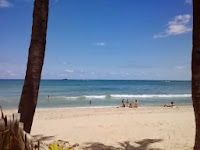
By Jane Feehan
Fort Lauderdale was image conscious from its earliest days. Preparing
for winter season visitors with clean-up squads was a common sight during the
1920s. “The entire city could feel the sweep of the city broom.”
Squads also cleaned up for school openings and baseball games. Beautification efforts included planting and removal of weeds, sand spurs and palmettos. It
wasn’t always about beautification and weeds and trash. Fort Lauderdale’s Board of Health cleared vegetation
to mitigate mosquito breeding.
Cleaning vacant lots and clearing the banks of waterways
produced some amusing results. Stories about the removal and cutting down of thick
undergrowth pull back the curtain on days before the city’s high-velocity development. In
1928 teams cleared weeds and other vegetative matter between Las Olas and south to the Casino Pool
for visitors and local beachgoers. New River and Las Olas beach were considered two of “the city’s greatest assets.”
City teams also cleaned up the Rio Vista neighborhood. Thanks
to the crew's work, residents reportedly could see across the river [New River] for
the first time as well as its boat traffic. It was also noted that the owners of an
apartment building “in a certain section of the city” adjacent to New River said
the clean-up squad made “the lovely stream visible.” As a result, the owners
raised rents “on the strength of the proximity to the water.”
In a West Las Olas neighborhood, a clean-up crew discovered sidewalks
the “public has almost forgotten.” A nearby vacant lot cleanup produced discarded
mattresses, automobiles, city sewer piping and live dynamite that had been buried
on the spot for two years.
Stranahan Field underwent some critical clean up in 1925
that minimized excuses for errors and improved its image. Baseballs hit to the
outfield were frequently lost in high grass and weeds. Cutting down the vegetation produced
a “first class ball field.”
Ross Clark, Board of Health president, said they could not clean up
the entire city. “People are going to have get involved in the “cleanup cause” if
we are to be absolutely pure and undefiled.” A cleanup week was designated by the city in
1936 to foster public participation in clean up activities.
We’re still not, nor could ever be, "absolutely pure and
undefiled," but people get involved today by volunteering for waterway and beach
cleanups. The city has relegated lot clearing to property owners and trash pickup
services.
Sources:
Fort Lauderdale News, June 24,
1925
Fort Lauderdale News, Sept. 6, 1928
Fort Lauderdale News, Oct. 12, 1928
Fort Lauderdale News, Dec. 15, 1928
Fort Lauderdale News, Nov. 1, 1930
Fort Lauderdale News, Sept. 9, 1931
Fort Lauderdale News, Dec. 14, 1936
Tags: Fort Lauderdale history, Fort Lauderdale in the 1920s, Fort Lauderdale in the 1930s














